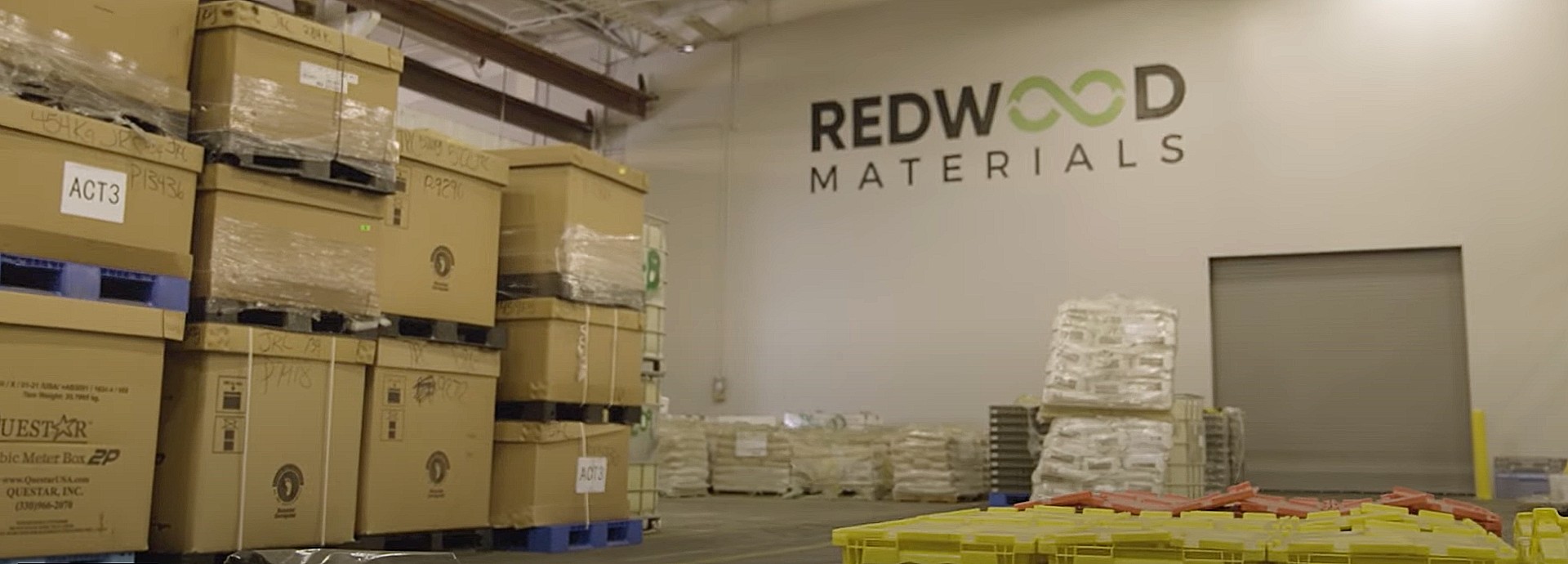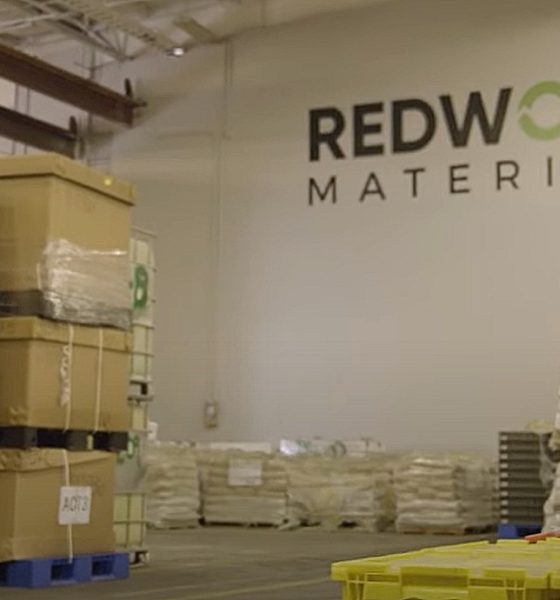

News
Ford and Volvo partner with Redwood Materials in pathways program for end-of-life EV batteries
Ford and Volvo have partnered with Redwood Materials for pathways for end-of-life electric vehicle batteries.
Founded by Tesla co-founder JB Straubel, Redwood Materials has now expanded its partnership with electric vehicle manufacturers to see that EV batteries are responsibly disposed of or recycled when they have reached the end of their life cycle. Redwood currently holds several partnerships, including one with Tesla and another with AESC, the manufacturer of Nissan LEAF battery packs.
The program will start in Redwood’s home state of California, the company said in a blog. The program is the most comprehensive EV recycling process globally, which aims to establish safe, efficient, and effective recovery pathways for end-of-life electric and hybrid-electric vehicles. Ford and Volvo are the first two automakers to join the program.
Tesla co-founder JB Straubel confirms Redwood’s battery recycling operations are already profitable
“To truly make electric vehicles sustainable and affordable, we need to create pathways for end-of-life battery packs to be collected, recycled and remanufactured into new battery materials,” Redwood said. “Scaling production of EVs, increasingly from recycled materials, domestically, is the only way we can create a circular and, therefore, sustainable and secure supply chain to meet the US’ electrification plans. While the first major wave of end-of-life electric vehicles is still a few years away, Redwood and our initial partners at Ford and Volvo are committed to creating these pathways now.”
Ford and Redwood established a partnership to recycle EV batteries last year.
“We are excited to be strengthening our partnership with Redwood Materials in identifying solutions for electric vehicle batteries that have reached the end of their useful lives,” Ford CEO Jim Farley said regarding the new layer of the partnership. “This new program with Redwood Materials will help Ford lead America’s transition to sustainable and carbon-neutral EV manufacturing and ultimately help make electric vehicles more sustainable and affordable for our customers. I want to thank JB and the Redwood team for bringing their world-class technology and know-how to our joint effort.”
Volvo’s XC40 Recharge EV is the beginning of the company’s trek to be climate neutral by 2040 and fully-electric by 2030. CEO of Volvo Car USA Anders Gustafsson said the company’s lofty goals for sustainability have the company excited about the partnership with Redwood. “At Volvo cars, sustainability is as important as safety. We aim to be climate neutral by 2040, and fully electric by 2030, and embracing a circular economy,” Gustafsson said. “This is why we are excited about Redwood Materials’ forward-thinking solutions for end-of-life battery packs to be collected, recycled and remanufactured. California is the right place to start such a program.”
Redwood said its pathways program will require it to work directly with dealers and dismantlers in California to identify and recover end-of-life packs. The packs will then be transferred to its facility in Northern Nevada to be recycled back into domestic cell production.
“Our goal is to learn and share those learnings with the industry. We will demonstrate the value of end-of-life packs today and how we can steadily improve those economics as volumes scale up. Ultimately, our aim is to create the most effective and sustainable closed-loop system that physics, and chemistry will allow for end-of-life battery packs to re-enter the domestic supply chain. We look forward to working with the State of California, dismantlers, dealers, and other automakers and hope to be a resource, sharing our results and learnings as we go,” Redwood said.
I’d love to hear from you! If you have any comments, concerns, or questions, please email me at joey@teslarati.com. You can also reach me on Twitter @KlenderJoey, or if you have news tips, you can email us at tips@teslarati.com.

Elon Musk
Elon Musk’s X will start using a Tesla-like software update strategy
The initiative seems designed to accelerate updates to the social media platform, while maintaining maximum transparency.

Elon Musk’s social media platform X will adopt a Tesla-esque approach to software updates for its algorithm.
The initiative seems designed to accelerate updates to the social media platform, while maintaining maximum transparency.
X’s updates to its updates
As per Musk in a post on X, the social media company will be making a new algorithm to determine what organic and advertising posts are recommended to users. These updates would then be repeated every four weeks.
“We will make the new 𝕏 algorithm, including all code used to determine what organic and advertising posts are recommended to users, open source in 7 days. This will be repeated every 4 weeks, with comprehensive developer notes, to help you understand what changed,” Musk wrote in his post.
The initiative somewhat mirrors Tesla’s over-the-air update model, where vehicle software is regularly refined and pushed to users with detailed release notes. This should allow users to better understand the details of X’s every update and foster a healthy feedback loop for the social media platform.
xAI and X
X, formerly Twitter, has been acquired by Elon Musk’s artificial intelligence startup, xAI last year. Since then, xAI has seen a rapid rise in valuation. Following the company’s the company’s upsized $20 billion Series E funding round, estimates now suggest that xAI is worth tens about $230 to $235 billion. That’s several times larger than Tesla when Elon Musk received his controversial 2018 CEO Performance Award.
As per xAI, the Series E funding round attracted a diverse group of investors, including Valor Equity Partners, Stepstone Group, Fidelity Management & Research Company, Qatar Investment Authority, MGX, and Baron Capital Group, among others. Strategic partners NVIDIA and Cisco Investments also continued support for building the world’s largest GPU clusters.
News
Tesla FSD Supervised wins MotorTrend’s Best Driver Assistance Award
The decision marks a notable reversal for the publication from prior years, with judges citing major real-world improvements that pushed Tesla’s latest FSD software ahead of every competing ADAS system.

Tesla’s Full Self-Driving (Supervised) system has been named the best driver-assistance technology on the market, earning top honors at the 2026 MotorTrend Best Tech Awards.
The decision marks a notable reversal for the publication from prior years, with judges citing major real-world improvements that pushed Tesla’s latest FSD software ahead of every competing ADAS system. And it wasn’t even close.
MotorTrend reverses course
MotorTrend awarded Tesla FSD (Supervised) its 2026 Best Tech Driver Assistance title after extensive testing of the latest v14 software. The publication acknowledged that it had previously criticized earlier versions of FSD for erratic behavior and near-miss incidents, ultimately favoring rivals such as GM’s Super Cruise in earlier evaluations.
According to MotorTrend, the newest iteration of FSD resolved many of those shortcomings. Testers said v14 showed far smoother behavior in complex urban scenarios, including unprotected left turns, traffic circles, emergency vehicles, and dense city streets. While the system still requires constant driver supervision, judges concluded that no other advanced driver-assistance system currently matches its breadth of capability.
Unlike rival systems that rely on combinations of cameras, radar, lidar, and mapped highways, Tesla’s FSD operates using a camera-only approach and is capable of driving on city streets, rural roads, and freeways. MotorTrend stated that pure utility, the ability to handle nearly all road types, ultimately separated FSD from competitors like Ford BlueCruise, GM Super Cruise, and BMW’s Highway Assistant.
High cost and high capability
MotorTrend also addressed FSD’s pricing, which remains significantly higher than rival systems. Tesla currently charges $8,000 for a one-time purchase or $99 per month for a subscription, compared with far lower upfront and subscription costs from other automakers. The publication noted that the premium is justified given FSD’s unmatched scope and continuous software evolution.
Safety remained a central focus of the evaluation. While testers reported collision-free operation over thousands of miles, they noted ongoing concerns around FSD’s configurable driving modes, including options that allow aggressive driving and speeds beyond posted limits. MotorTrend emphasized that, like all Level 2 systems, FSD still depends on a fully attentive human driver at all times.
Despite those caveats, the publication concluded that Tesla’s rapid software progress fundamentally reshaped the competitive landscape. For drivers seeking the most capable hands-on driver-assistance system available today, MotorTrend concluded Tesla FSD (Supervised) now stands alone at the top.
News
Elon Musk’s Grokipedia surges to 5.6M articles, almost 79% of English Wikipedia
The explosive growth marks a major milestone for the AI-powered online encyclopedia, which was launched by Elon Musk’s xAI just months ago.

Elon Musk’s Grokipedia has grown to an impressive 5,615,201 articles as of today, closing in on 79% of the English Wikipedia’s current total of 7,119,376 articles.
The explosive growth marks a major milestone for the AI-powered online encyclopedia, which was launched by Elon Musk’s xAI just months ago. Needless to say, it would only be a matter of time before Grokipedia exceeds English Wikipedia in sheer volume.
Grokipedia’s rapid growth
xAI’s vision for Grokipedia emphasizes neutrality, while Grok’s reasoning capabilities allow for fast drafting and fact-checking. When Elon Musk announced the initiative in late September 2025, he noted that Grokipedia would be an improvement to Wikipedia because it would be designed to avoid bias.
At the time, Musk noted that Grokipedia “is a necessary step towards the xAI goal of understanding the Universe.”
Grokipedia was launched in late October, and while xAI was careful to list it only as Version 0.1 at the time, the online encyclopedia immediately earned praise. Wikipedia co-founder Larry Sanger highlighted the project’s innovative approach, noting how it leverages AI to fill knowledge gaps and enable rapid updates. Netizens also observed how Grokipedia tends to present articles in a more objective manner compared to Wikipedia, which is edited by humans.
Elon Musk’s ambitious plans
With 5,615,201 total articles, Grokipedia has now grown to almost 79% of English Wikipedia’s article base. This is incredibly quick, though Grokipedia remains text-only for now. xAI, for its part, has now updated the online encyclopedia’s iteration to v0.2.
Elon Musk has shared bold ideas for Grokipedia, including sending a record of the entire knowledge base to space as part of xAI’s mission to preserve and expand human understanding. At some point, Musk stated that Grokipedia will be renamed to Encyclopedia Galactica, and it will be sent to the cosmos.
“When Grokipedia is good enough (long way to go), we will change the name to Encyclopedia Galactica. It will be an open source distillation of all knowledge, including audio, images and video. Join xAI to help build the sci-fi version of the Library of Alexandria!” Musk wrote, adding in a later post that “Copies will be etched in stone and sent to the Moon, Mars and beyond. This time, it will not be lost.”








